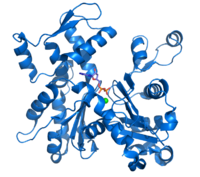
Photo from wikipedia
Abstract The present paper reports on the first application of a polymer inclusion membrane (PIM) for the extraction of the bismuth(III) ion. Best results in terms of rate of Bi(III)… Click to show full abstract
Abstract The present paper reports on the first application of a polymer inclusion membrane (PIM) for the extraction of the bismuth(III) ion. Best results in terms of rate of Bi(III) extraction and amount extracted were achieved with a PIM composition of 50 wt% poly(vinyl chloride) as the base polymer and 50 wt% bis(2-ethylhexyl)phosphoric acid (D2EHPA) as the extractant and a feed solution adjusted to pH 1.3 and containing 0.2 mol L−1 sulfate. The back-extraction of Bi(III) was performed quantitatively in a 2 mol L−1 H2SO4 receiving solution. No deterioration in the PIM performance was observed in 15 consecutive extraction/back-extraction cycles and the membrane lost less than 4% of its mass when exposed to ambient air or a feed solution with the optimal composition mentioned above. The stoichiometry of the extracted Bi(III)-D2EHPA adduct was established to be BiL3(HL)3 where HL denotes D2EHPA. High selectivity for Bi(III) was achieved in the presence of common base metal ions such as Cu(II), Ni(II), Zn(II), Cd(II), Fe(III), Cr(III), Co(II), Mn(II), Al(III), and Mo(VI). The co-extraction of Fe(III) was suppressed by complexing it with fluoride. Fourier transform infrared spectroscopy, scanning electron microscopy, atomic force microscopy, contact angle measurements, thermogravimetric analysis, and stress-strain analysis were used for characterizing the PIM mentioned above.
Journal Title: Reactive and Functional Polymers
Year Published: 2021
Link to full text (if available)
Share on Social Media: Sign Up to like & get
recommendations!